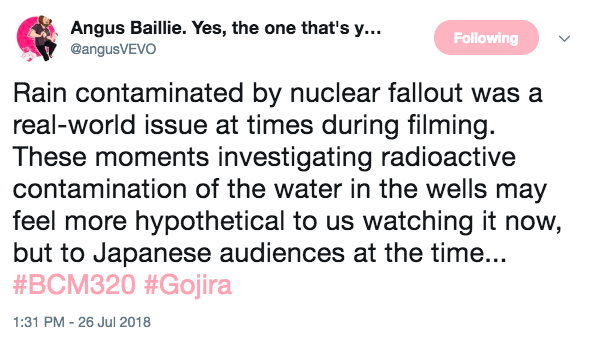Ellis et al (2011) explains that ‘Autoethnography is an approach to research and writing that seeks to describe and systematically analyse personal experience in order to understand cultural experience.‘
Watching Gojira (1954) involved my engagement in the autoethnographic process. Unfortunately, I was absent during the screening due to travelling, however I made sure to catch up on the film over the weekend once home. I would first like to provide you with some information about my own background to enable understanding of my personal experience. You see, my father is from a town called Catania on the east coast of Sicily, and my mother is as Australian as they come – born and bred in a little town called Forbes in country New South Wales. This meant that I never really had any Asian media influence growing up apart from watching Digimon and Yu Gi Oh! with my twin brother each morning on Toasted TV. It is also safe to say that the closest thing I ever saw that resembled Godzilla was Reptar from the Rugrats.

Reptar. Source.
From my understanding of the film, having the Gojira monster leave a path of destruction metaphorically resembles the effects of the nuclear bombings of Nagasaki and Hiroshima. If we as the audience place ourselves in the time period of when this film was released (Post-World War II), it is clear to see how the film’s aim was to depict the real devastation that would have been felt by the people of Japan at the time. My paternal grandfather was conscripted into the Italian army at 20 years old and from the limited stories I heard growing up (limited due to his preference not to talk about it), it was a pretty rough situation to be in – thus, I can only imagine the dramatic effects something like the Nagasaki and Hiroshima bombings had on Japanese society.
As far as live-tweeting goes, I’m a little unashamed to say I have live-tweeted an episode or two of The Bachelor in my time. Although unable to live-tweet this screening in class myself, I appreciated that the understanding of the film shone through the insightful tweets of others present during the class. Here are some examples:
During my uni-break I travelled to Budapest and it was there that I visited a place called the Hospital in the Rock, a hospital created in underground caverns during World War II which was used to treat soldiers and civilians. It is now a museum and it has one room showcasing photos and videos of the overwhelming and harrowing effects of Hiroshima. Absolutely unbelievable. It certainly stuck with me and I thought about it the whole time I was watching Gojira and this allowed feelings of both sympathy and empathy to arise.
Despite Godzilla becoming an icon in popular culture with a still-active international franchise (Godzilla: King of the Monsters coming in 2019), the 1954 classic still assists viewers with becoming aware of the real world issues of the time. This was a fantastic way to kick off BCM320 and provided a stellar introduction to the meaning and process of autoethnography.
Reference List:
- Ellis, C, Adams, TE, & Bochner, AP 2011, ‘Autoethnography: An Overview’, Forum: Qualitative Social Research, vol. 12, no. 1, viewed 30 July 2018, <http://www.qualitative-research.net/index.php/fqs/article/view/1589/3095>.


